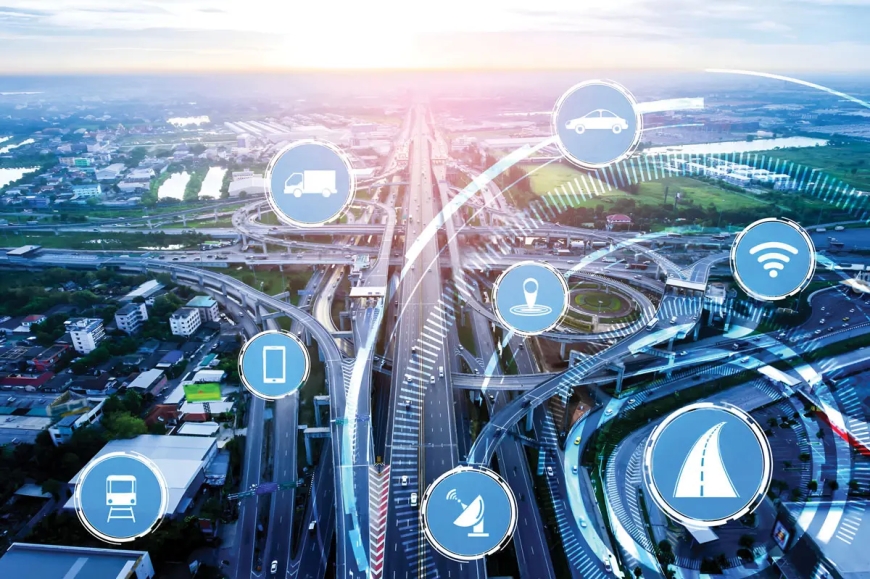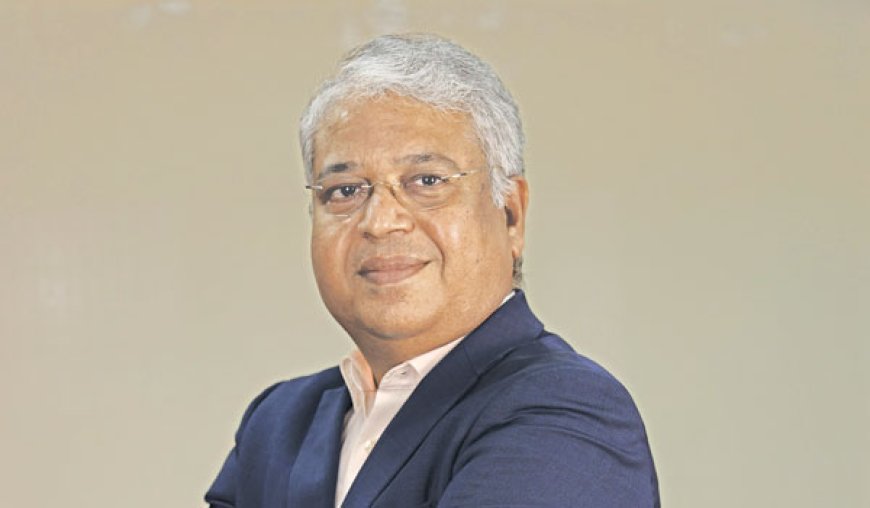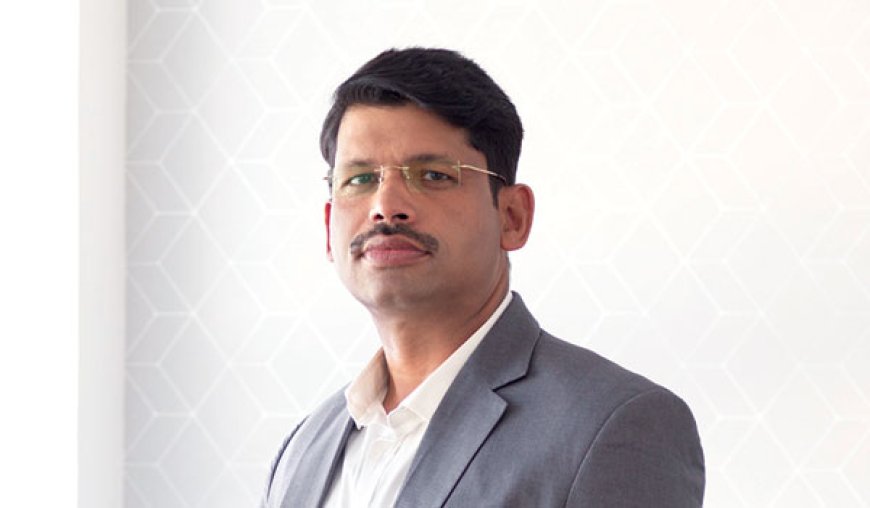Building Smart Roads
India’s roads and highways sector is gradually transforming to qualitative from quantitative by introducing smart technologies and digital innovations in the building and maintenance of the projects.

India’s roads and highways sector is gradually transforming to qualitative from quantitative by introducing smart technologies and digital innovations in the building and maintenance of the projects. Construction Times explores the need for smart roads in future.
Roads and highways still play an important role in India’s transportation and logistics needs. In spite of the recent growth in railways and metro rail networks in the country, roads continue to meet most of the transportation needs currently. India has the second-largest road network in the world, with a total length of 66.71 lakh km and roads currently handle approximately 85% of passenger traffic and over 60% of freight in the country.
Emerging trends
India has witnessed a major progress in the recent years in building bigger roads and highways across the country. As per the Ministry of Road Transport and Highways (MoRTH), India’s National Highway network has grown by 60% over the past decade, expanding from 91,287 km in 2014 to 146,195 km by 2024. High-speed corridors have surged from 93 km to 2,474 km, significantly enhancing road connectivity across the nation. The length of highways (four-lane and above) has more than doubled, increasing from 18,278 km in 2014 to 45,947 km, ensuring smoother and faster transportation for commuters and goods.
Safe roads
Road safety has become a high priority in the recent times, as reports on many accidents on the newly constructed highways and expressways have a negative impact on the development of roads and highway projects in the country. Union Road Transport and Highways Minister Nitin Gadkari recently said that road accidents and fatalities in India are increasing. The major reasons are attributed to a section of the civil engineers, substandard detailed project reports (DPRs), consultants, and concessionaires, according to him. Proper design and construction of roads play a vital role in building safe roads and highways in the country.
The government aims to reduce road accidents and fatalities by half by 2030, in line with the United Nation’s Second Decade of Action on Road Safety, by adopting safety in the road planning stage and providing additional services on built roads. With over 1.7 lakh fatalities annually, road accidents cause a significant socio-economic impact, accounting for a 3.14% loss in gross domestic product (about Rs 5 lakh crore), according to CRISIL. The revised Advanced Traffic Management System circular of 2023 introduces advanced electronics and artificial intelligence-enabled technologies to enhance traffic management.
 “DPR for a road project must ensure a balance between design efficiency and long-term quality,” highlights Daleep Thusu, Transportation Expert, Rudrabhishek Enterprises Ltd (REPL). According to him, key factors include terrain assessment, traffic projections and alignment optimization to ensure smooth connectivity and minimal environmental impact. He also highlights the key parameters that will enhance and support safety in road & highway construction, “Smooth curves, sufficient sight distances and strategically positioned intersections in proper alignment planning minimize the possibility of accidents. Roadside safety features, such as crash barriers, guardrails and pedestrian walkways, are essential. High-quality materials and strict construction standards ensure pavement durability and minimize hazards like potholes and rutting. Efficient drainage systems prevent waterlogging, reducing skidding risks. Periodic inspections and safety checks ensure that the risks are foreseen and fixed before they manifest. Lastly, technology incorporation through intelligent traffic management systems and live monitoring improves the overall safety on roads.”
“DPR for a road project must ensure a balance between design efficiency and long-term quality,” highlights Daleep Thusu, Transportation Expert, Rudrabhishek Enterprises Ltd (REPL). According to him, key factors include terrain assessment, traffic projections and alignment optimization to ensure smooth connectivity and minimal environmental impact. He also highlights the key parameters that will enhance and support safety in road & highway construction, “Smooth curves, sufficient sight distances and strategically positioned intersections in proper alignment planning minimize the possibility of accidents. Roadside safety features, such as crash barriers, guardrails and pedestrian walkways, are essential. High-quality materials and strict construction standards ensure pavement durability and minimize hazards like potholes and rutting. Efficient drainage systems prevent waterlogging, reducing skidding risks. Periodic inspections and safety checks ensure that the risks are foreseen and fixed before they manifest. Lastly, technology incorporation through intelligent traffic management systems and live monitoring improves the overall safety on roads.”
 According to Trupti Nayak, COO, Rajpath Infracon Pvt Ltd, this year there has been an unequivocal accent on road construction safety at all levels, starting right from MoRTH and NHAI. “Today, road & highway construction safety initiatives encompass worker protection, traffic management, and public awareness, including mandatory safety audits, proper signage, traffic control measures, and robust training programs.”
According to Trupti Nayak, COO, Rajpath Infracon Pvt Ltd, this year there has been an unequivocal accent on road construction safety at all levels, starting right from MoRTH and NHAI. “Today, road & highway construction safety initiatives encompass worker protection, traffic management, and public awareness, including mandatory safety audits, proper signage, traffic control measures, and robust training programs.”
Building roads: A smarter approach
 India’s roads and highways developments are in line with the Vision 2047 that aims to revolutionise the country’s infrastructure landscape. The government is building a technologically advanced and resilient highway network. “The future highway projects under this vision will not only expand the national road network, but also harness cutting-edge technologies, such as digital monitoring platforms, smart traffic management systems, and sustainable materials. These initiatives will ensure that the highways are not only more efficient and safer, but also environmentally sustainable, contributing to India’s broader goals of economic growth, improved connectivity, and a higher quality of life for its citizens,” Prabhakar Kumar, Head - Government Consulting, Rudrabhishek Enterprises Limited (REPL). The development of high-profile projects like the Delhi-Mumbai Expressway, Eastern Peripheral Expressway, Dwarka Expressway, Delhi-Katra Expressway, Mumbai-Nagpur Samruddhi Expressway etc, is in line with this vision of transformation. According to Kumar, these highways will not just be roads but smart highways equipped with advanced technology for real-time traffic monitoring, automated tolling, and AI-driven traffic management systems. The inclusion of green technologies, such as solar-powered streetlights and electric vehicle (EV) charging stations, will ensure that these projects align with India’s sustainability goals.
India’s roads and highways developments are in line with the Vision 2047 that aims to revolutionise the country’s infrastructure landscape. The government is building a technologically advanced and resilient highway network. “The future highway projects under this vision will not only expand the national road network, but also harness cutting-edge technologies, such as digital monitoring platforms, smart traffic management systems, and sustainable materials. These initiatives will ensure that the highways are not only more efficient and safer, but also environmentally sustainable, contributing to India’s broader goals of economic growth, improved connectivity, and a higher quality of life for its citizens,” Prabhakar Kumar, Head - Government Consulting, Rudrabhishek Enterprises Limited (REPL). The development of high-profile projects like the Delhi-Mumbai Expressway, Eastern Peripheral Expressway, Dwarka Expressway, Delhi-Katra Expressway, Mumbai-Nagpur Samruddhi Expressway etc, is in line with this vision of transformation. According to Kumar, these highways will not just be roads but smart highways equipped with advanced technology for real-time traffic monitoring, automated tolling, and AI-driven traffic management systems. The inclusion of green technologies, such as solar-powered streetlights and electric vehicle (EV) charging stations, will ensure that these projects align with India’s sustainability goals.
According to CRISIL, the preparation of Detailed Project Reports (DPRs) has undergone policy-level interventions, focusing on improving coverage and outcomes. DPRs now require the use of remote sensing technologies (e.g., LiDAR), drone satellite imagery and updated Survey of India data to survey ground features and gather topography and survey data. The use of modern technology, such as network survey vehicle for road condition assessments and aerial surveys and terrestrial LiDAR for greenfield alignment planning, has been made mandatory.
 It is also imperative to use digital technologies in roads and highways construction. According to Sunil MK, Director, Business Development – Asia, Bentley Systems, digital technologies are revolutionising road and highway construction by enhancing efficiency, accuracy, and sustainability. “Digital twins, for instance, create dynamic, data-driven replicas of infrastructure assets, improving decision-making throughout the project lifecycle—from design and construction to operation and maintenance. AI-powered insights, IoT-enabled sensors, and advanced analytics facilitate real-time monitoring of construction activities, optimising schedules, reducing delays, and controlling costs. These technologies also enhance stakeholder collaboration, minimise risks, and ensure seamless project execution,” Sunil adds. The integration of digital technologies will further accelerate project execution, ensuring that road networks are sustainable, efficient, and high-performing.
It is also imperative to use digital technologies in roads and highways construction. According to Sunil MK, Director, Business Development – Asia, Bentley Systems, digital technologies are revolutionising road and highway construction by enhancing efficiency, accuracy, and sustainability. “Digital twins, for instance, create dynamic, data-driven replicas of infrastructure assets, improving decision-making throughout the project lifecycle—from design and construction to operation and maintenance. AI-powered insights, IoT-enabled sensors, and advanced analytics facilitate real-time monitoring of construction activities, optimising schedules, reducing delays, and controlling costs. These technologies also enhance stakeholder collaboration, minimise risks, and ensure seamless project execution,” Sunil adds. The integration of digital technologies will further accelerate project execution, ensuring that road networks are sustainable, efficient, and high-performing.
 Digital technologies ensure timely execution and improved resource management by adding more accuracy, efficiency, and transparency to infrastructure projects. Harsh Pareek, Regional Sales Director, India and SAARC, Trimble Solutions, elaborates, “In order to ensure precise, sustainable, and high-quality road and highway construction, advanced digital solutions are essential. LiDAR and high-accuracy GPS are examples of modern surveying tools allowing for detailed mapping and planning, reducing errors before construction begins. This results in better alignment, smoother roads, and enhanced durability.”
Digital technologies ensure timely execution and improved resource management by adding more accuracy, efficiency, and transparency to infrastructure projects. Harsh Pareek, Regional Sales Director, India and SAARC, Trimble Solutions, elaborates, “In order to ensure precise, sustainable, and high-quality road and highway construction, advanced digital solutions are essential. LiDAR and high-accuracy GPS are examples of modern surveying tools allowing for detailed mapping and planning, reducing errors before construction begins. This results in better alignment, smoother roads, and enhanced durability.”
 Use of construction equipment with digitally enabled advanced features will add value to project execution by delivering unparalleled precision, efficiency, and sustainability. V G Sakthikumar, Chairman & Managing Director, Schwing Stetter India, adds, “Our cylinder finishers ensure uniform surface finishing, while our advanced concrete boom pumps guarantee accuracy, minimizing material wastage. High-output batching plants streamline operations, reducing project timelines and optimizing workforce utilization.”
Use of construction equipment with digitally enabled advanced features will add value to project execution by delivering unparalleled precision, efficiency, and sustainability. V G Sakthikumar, Chairman & Managing Director, Schwing Stetter India, adds, “Our cylinder finishers ensure uniform surface finishing, while our advanced concrete boom pumps guarantee accuracy, minimizing material wastage. High-output batching plants streamline operations, reducing project timelines and optimizing workforce utilization.”
 “At Volvo CE India, we are committed to delivering high-performance construction equipment that enhances the quality, precision, and sustainability of road and highway development. Our advanced pavers, compactors, and excavators are engineered for superior efficiency, ensuring smooth and durable road surfaces. With intelligent automation and telematics, our machines enable precise material distribution, optimized fuel consumption, and reduced emissions,” says Dimitrov Krishnan, Managing Director, Volvo CE India.
“At Volvo CE India, we are committed to delivering high-performance construction equipment that enhances the quality, precision, and sustainability of road and highway development. Our advanced pavers, compactors, and excavators are engineered for superior efficiency, ensuring smooth and durable road surfaces. With intelligent automation and telematics, our machines enable precise material distribution, optimized fuel consumption, and reduced emissions,” says Dimitrov Krishnan, Managing Director, Volvo CE India.
Smarter future ahead
India's road and highway development is poised for significant advancements in 2025-26 and beyond. The government has set a target to construct 10,000 km of national highways, including 5,800 km of high-speed corridors. According to Pareek, besides constructing more roads, the objective is to make sure they are strong, carefully designed, and able to manage growing traffic demands while having the least negative effects on the environment. “Enhancing construction accuracy through automated machinery and advanced surveying is a top priority since it reduces errors, material waste, and structural weaknesses. Digital workflows for more intelligent project planning and execution can also improve quality control, guaranteeing long-lasting roads,” he adds.
Sakthikumar says, “The Indian roads & highways sector is poised for significant growth, driven by the expansion of expressways, green corridors, and smart road networks. The integration of AI, IoT, and automation in road construction is expected to improve efficiency, reduce construction timelines, and enhance overall project quality.”
Sustainability will play a major role in the upcoming highway projects. The industry is adopting eco-friendly practices to reduce carbon emissions. Recycling and re-processing are the key initiatives, with shredded waste plastic used as a substitute for bitumen in roads, sequestering carbon. The inclusion of green technologies, such as solar-powered streetlights and electric vehicle (EV) charging stations, will ensure that these projects align with India’s sustainability goals.
Smart features and solutions hold the key for roads and highways for the coming years as the government is gradually shifting its focus more towards qualitative approach rather than quantity. Instead of announcing more projects and allocating increased funds in budget, the goal should be constructing roads and highways of desired quality and making it safer and sustainable.







